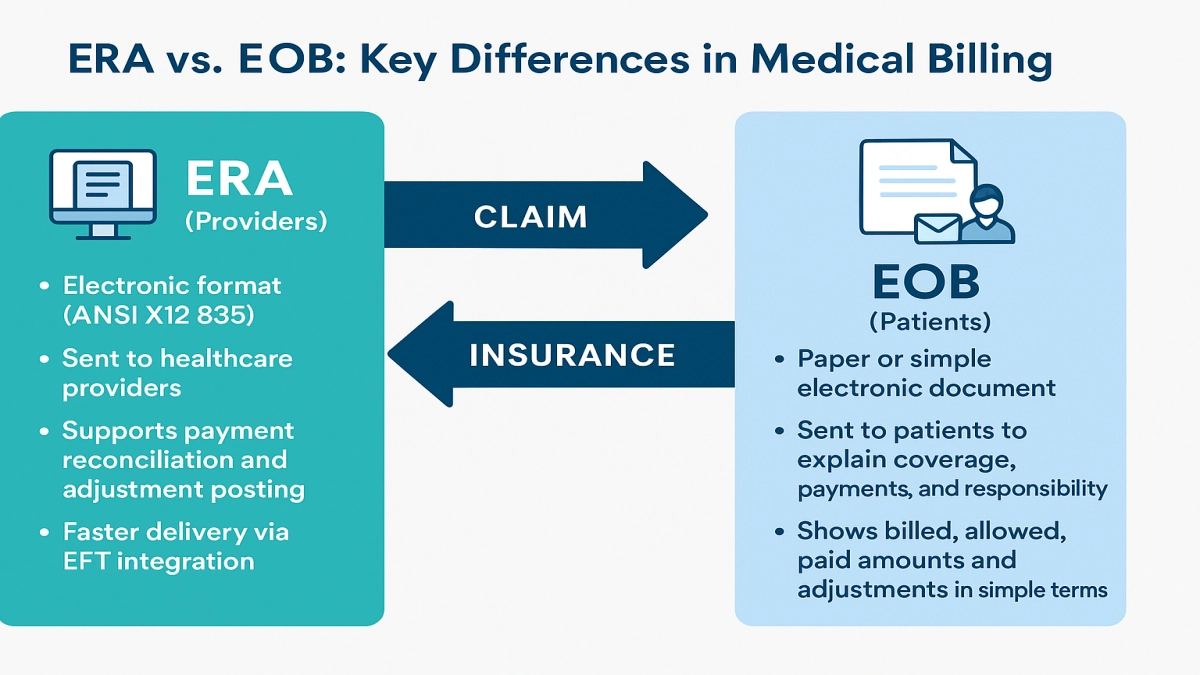The Electronic Remittance Advice (ERA) and the Explanation of Benefits (EOB) both explain how a healthcare claim was processed but they serve different audiences. EOBs are typically sent to patients by their health insurance provider. In contrast, ERAs are sent electronically to healthcare providers to explain the payment and claim status.
🧾 What Is an EOB?
An Explanation of Benefits (EOB) is a paper or digital statement patients receive from their insurance company after a medical service is processed. It breaks down what the provider charged, how much the insurer paid, what was denied, and how much the patient may owe.
Key Purpose: Helps patients understand their share of costs
Format: Typically mailed or accessed through a patient portal
💻 What Is an ERA?
An Electronic Remittance Advice (ERA) is a digital document sent to providers and billing systems that outlines claim payments, denials, and adjustments. It’s part of an automated billing system and works with electronic health records (EHRs) to streamline financial processes.
Key Purpose: Helps providers manage payment records and rejections
Format: Delivered digitally via secure clearinghouses
📊 Quick Comparison Chart
| Feature | EOB (Explanation of Benefits) | ERA (Electronic Remittance Advice) |
|---|---|---|
| Audience | Patients | Providers |
| Format | Paper/Digital | Electronic Only |
| Use | Explains benefits and costs | Payment posting and reconciliation |
| Access Method | Patient portal or mail | Clearinghouse/EHR systems |
| Actionable Insight | Patient billing transparency | Revenue cycle management |
⚠️ Why It Matters
Understanding the difference between ERA and EOB ensures better communication between providers and patients. For patients, it means transparency in billing. For providers, it streamlines the revenue cycle, reduces manual errors, and improves claim processing efficiency.
🧠 Final Thoughts: Clarity Improves Billing
Both ERA and EOB help clarify medical billing—but for different users. Using them correctly ensures timely payments, accurate patient charges, and reduced claim denials. Whether you’re a provider or patient, knowing the difference improves trust and financial accuracy.
Frequently Asked Question
EOB (Explanation of Benefits) is a patient-facing document from insurers detailing claim processing, patient responsibility, and payment.
ERA (Electronic Remittance Advice) is an electronic version sent to providers, containing payment details, adjustments, and claim denials for easier billing reconciliation.
ERA (Electronic Remittance Advice) is a digital report from payers to healthcare providers, summarizing claim payments, adjustments, and denials in a standardized format (often ANSI 835).
The ERA code refers to the ANSI X12 835 transaction standard, the electronic format used for remittance advice in medical billing, containing payment details, claim adjustments, and denial reasons.

